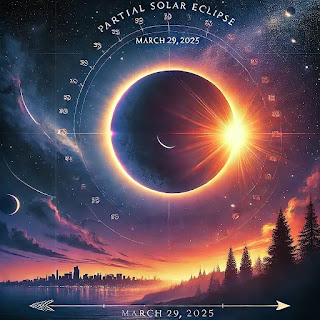A celestial treat is on the horizon! On March 29, 2025, a partial solar eclipse will be visible across parts of North America, offering a mesmerizing display for sky-watchers. This is the first solar eclipse of 2025, and it promises to be a significant event for both astronomy enthusiasts and casual observers alike.

Understanding the Partial Solar Eclipse
A solar eclipse occurs when the Moon passes between Earth and the Sun, either partially or totally blocking the Sun's light. In the case of a partial solar eclipse, the Moon covers only a portion of the Sun's disk. This results in a striking visual effect, where the Sun appears as a crescent or looks as if a "bite" has been taken out of it.
Where and When to Watch the Eclipse
The extent of the eclipse’s visibility will depend on your location. Here’s a breakdown of what to expect:
Northeastern United States: States like Maine will experience up to 85% of the Sun being obscured.
Eastern Canada: Some areas will see up to 93% coverage of the Sun.
Other Regions: While the most dramatic views will be in the Northeast, many other areas in North America will also witness partial obscuration.
Eclipse Timing
United States: The eclipse will be visible between 6:13 a.m. and 7:17 a.m. Eastern Daylight Time (EDT).
Canada: Viewers can expect the eclipse to occur between 6:56 a.m. Newfoundland Daylight Time (NDT) and 8:20 a.m. EDT, depending on their location.
For the best experience, ensure you have an unobstructed view of the eastern horizon.
How to Safely View the Eclipse
Observing a solar eclipse without proper precautions can cause permanent eye damage. Follow these safety guidelines:
Wear Eclipse Glasses: Use only ISO 12312-2 certified solar viewing glasses.
Use Indirect Viewing Methods: A pinhole projector can safely project the eclipse onto a flat surface.
Equip Cameras and Telescopes with Solar Filters: Regular lenses cannot protect against harmful solar radiation.
Weather Forecast and Viewing Conditions
Since clear skies are essential for viewing the eclipse, here’s an early look at the forecast for select cities:
New York, NY: Partly sunny, breezy. High: 73°F (23°C)
Chicago, IL: Variable cloudiness, possible showers. High: 62°F (16°C)
Miami, FL: Cloudy with a chance of showers. High: 81°F (27°C)
Check your local weather forecast closer to the event and plan accordingly.
How to Capture the Eclipse
If you're interested in photographing this stunning event, keep these tips in mind:
Use a Solar Filter: Prevent sensor damage by equipping your camera with a solar filter.
Use a Tripod: This helps stabilize your camera for long-exposure shots.
Practice Before the Event: Familiarize yourself with your camera settings ahead of time.
Frequently Asked Questions (FAQs)
1. What is a partial solar eclipse?
A partial solar eclipse occurs when the Moon blocks only a portion of the Sun, creating a crescent-like appearance.
2. How is a partial eclipse different from a total eclipse?
A total solar eclipse occurs when the Moon completely covers the Sun, while a partial eclipse leaves part of the Sun visible.
3. Can I look at a partial solar eclipse without protection?
No! Always use eclipse glasses or indirect viewing methods to protect your eyes.
4. Where can I buy eclipse glasses?
ISO-certified eclipse glasses are available at major retailers like Walmart, Staples, and online astronomy shops.
5. What if the weather is cloudy?
If skies are overcast, you may not be able to view the eclipse. Consider traveling to a location with clearer conditions.
6. When is the next solar eclipse?
The next solar eclipse will occur on September 21, 2025, which will also be a partial eclipse.
Final Thoughts
The partial solar eclipse on March 29, 2025, is a must-see event. Whether you're a seasoned astronomer or a first-time observer, make sure to mark your calendars, prepare your eclipse glasses, and check your local weather for the best viewing experience.
Stay safe, enjoy the view, and don't forget to share your eclipse moments on social media!






